▲ Blown green glass prunted Roemer with other vessels and food .
Rheinsberg 1762-1866 — City or town of major fayence stein production. For more info, see: http://www.thepatriotexchange.com/pss/hisfai.htm 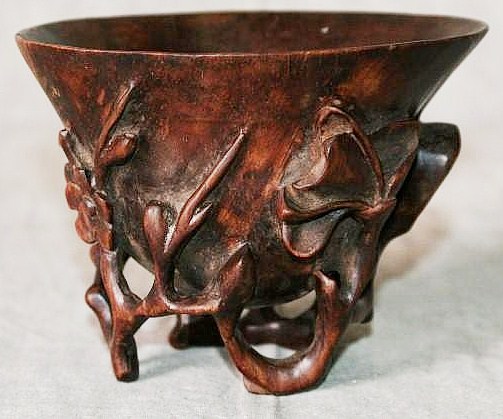 18th- 19th Cent. Chinese carved Rhino horn Libation cup. H3″ x L4.5″ x W4″
18th- 19th Cent. Chinese carved Rhino horn Libation cup. H3″ x L4.5″ x W4″
Rhino horn libation cup – A small hand held cup carved from a rhino’s horn. Drinking from one of these is thought to increase sexual prowess by Asians. Therefore several 1,000’s of these wonderful almost 2 ton (An adult weighs from 850 to 1,600 kg (1,900 to 3,500 lb) animals have been killed just for a little pussy!
Rhino horn server – A serving stein made out of a real rhino horn and capped with a silver rendition of a rhino’s head. As Rhino horns are quite highly thought of in the Orient most of these end up there. These are rare! 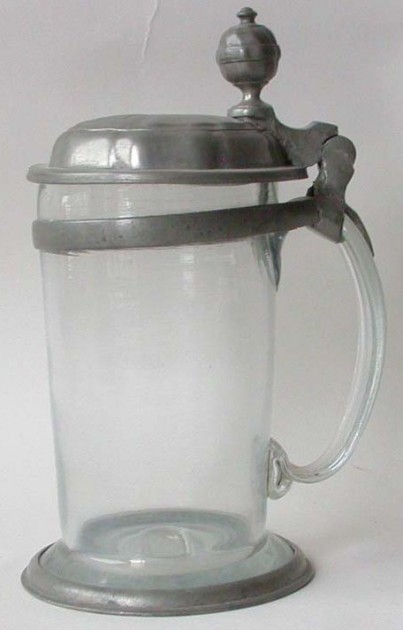
Ribbon handle – A blown glass handle which is flat on both sides and very thin and subject to easy breakage This type handle can be found on almost all glass steins made in the 1700’s up to about 1810. After that the handle will be found with a rounded side, on the side away from the body, while still a flat surface on the underneath Shown ▲: Stein is dated 1804. 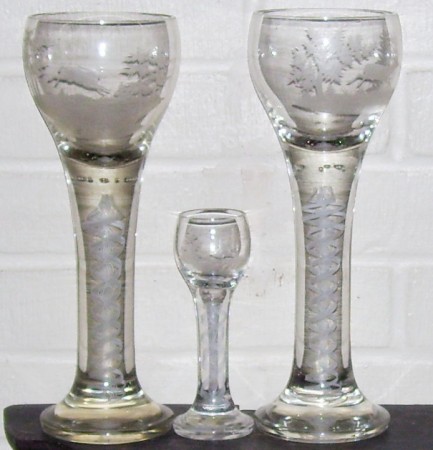 Ribbon stemmed – Also called “twisted stem.” Glass stems on wines, etc, to which have been added (while the clear glass is hot) a pre-made white glass ribbon, then twisted in the hot glass and finished later. A very difficult process. Shown: Three blown clear glass roemers with twisted ribbon stems, made by Josephinenhütte and engraved with animals for hunting scenes. [Stephen Smith Collection]
Ribbon stemmed – Also called “twisted stem.” Glass stems on wines, etc, to which have been added (while the clear glass is hot) a pre-made white glass ribbon, then twisted in the hot glass and finished later. A very difficult process. Shown: Three blown clear glass roemers with twisted ribbon stems, made by Josephinenhütte and engraved with animals for hunting scenes. [Stephen Smith Collection] 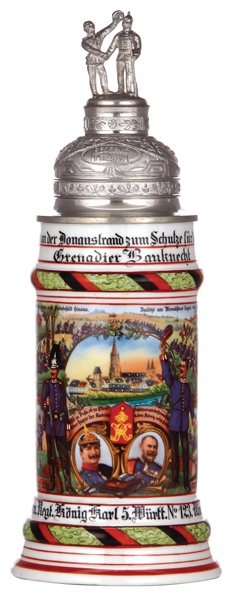 Ribbed – Having engraved, relief, or molded line features that run parallel to the ground. Most later dated (say 1908 +) Reservist steins have two ribs upon which their respective “State colors” are shown. These are found above and below the main scene. Above ▲: Reservist’s stein from Wurttemburg with it’s state’s stripes of black and red on its two “Ribs.” [TSACO] .
Ribbed – Having engraved, relief, or molded line features that run parallel to the ground. Most later dated (say 1908 +) Reservist steins have two ribs upon which their respective “State colors” are shown. These are found above and below the main scene. Above ▲: Reservist’s stein from Wurttemburg with it’s state’s stripes of black and red on its two “Ribs.” [TSACO] . 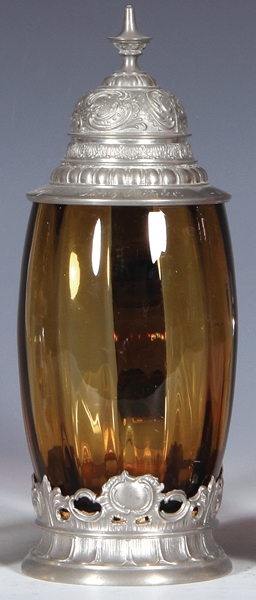 This stein is “Fluted” on the insiide; not “Ribbed” as a USA stein auctioneer recently called it. See “Fluted” in this compendium. Photo is of a Theresienthal glashütte stein. Circa 1890.
This stein is “Fluted” on the insiide; not “Ribbed” as a USA stein auctioneer recently called it. See “Fluted” in this compendium. Photo is of a Theresienthal glashütte stein. Circa 1890. 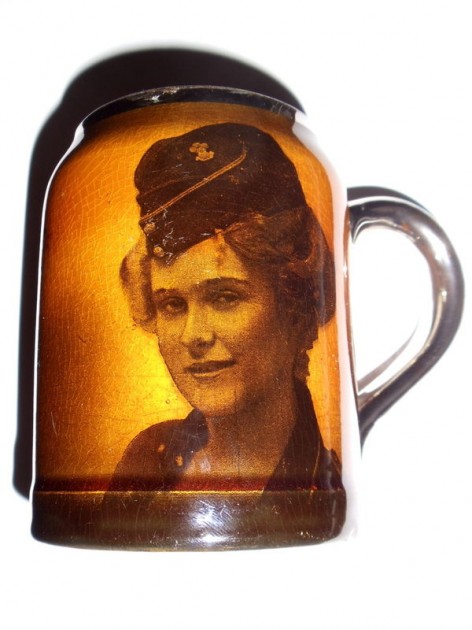
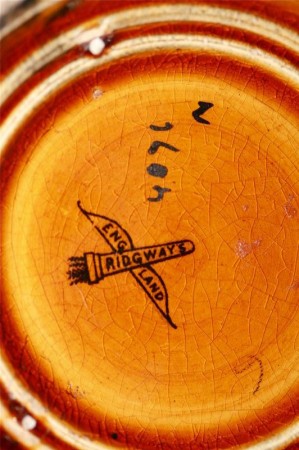
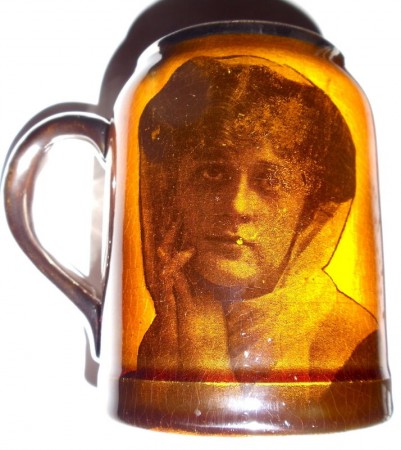
Ridgways Pottery, England – Maker of small pottery beer mugs during World War II. Shown: Welsh Regiment Beer Mug – Girl Wearing OS Hat. 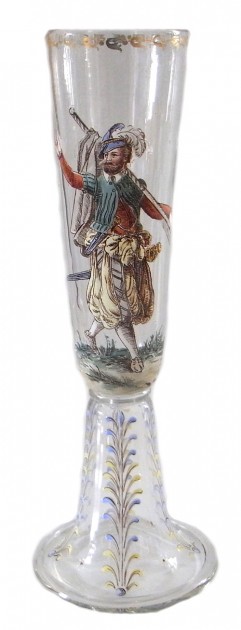
Riedel glass – From Riedel’s web page: Tradition and innovation – the Riedel company can proudly look back on its 250-year success story. From its beginnings in northern Bohemia down to this day, for 11 generations (for now) Riedel Glass has stood for the high art of glassmaking. In 1673, when Johann Christoph Riedel was born in the Bohemian town of Neuschloß, no one could have guessed that this was also the birth of one of the greatest glass enterprises in the world. This Bohemian glass merchant was the starting point for a direct line through several generations down to today´s corporate head Georg J. Riedel and his son Maximillian. Each Riedel in this long chain has been able to contribute his personal skills and views to expand the company´s success and make it what it is today. Shown ▲: A large pokal done with hand enameled work of a Lansquenet(not a Cavalier!) Ca. 1880. see: http://www.steveonsteins.com/lansquenets-on-beer-steins-etc-started-10-30-xing-as-i-go 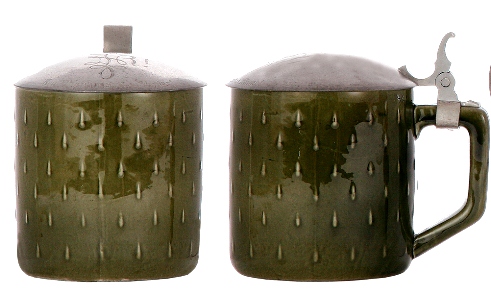 Riemerschmid, Richard – A well known Art Deco German stein designer. Shown: One of his credited stein designs. Below, a couple of others designed by R. Riemerschmid.
Riemerschmid, Richard – A well known Art Deco German stein designer. Shown: One of his credited stein designs. Below, a couple of others designed by R. Riemerschmid. 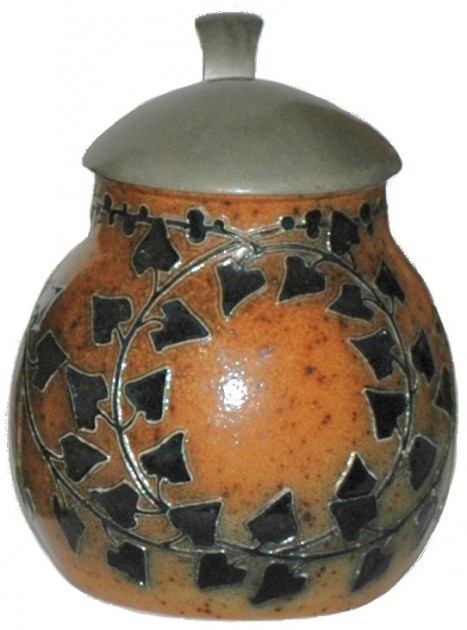
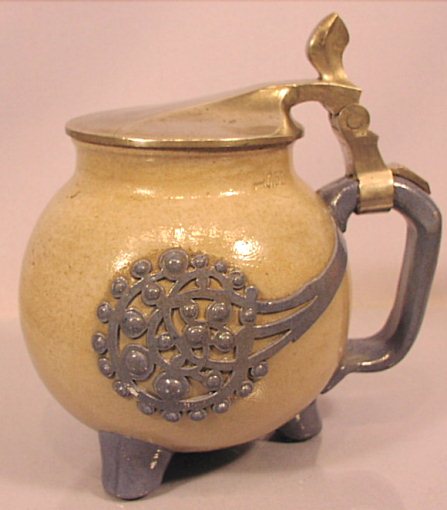
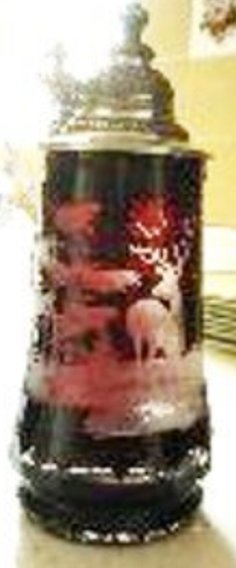
Rimpler – Kristall – A newer glass firm making stained cut glass steins in the old manner. Very good quality. Now located in Theresienthal, Germany. From their website (with a “Goggle” interp): “My grandfather, Emil Rimpler, who was trained in the Haida Glass School in North Bohemia as an engraver and designer, and then ran a craft workshop for glass in Bohemia. In 1946, the company in Zwiesel Rimpler CRYSTAL. His love and deep connection to the precious material glass Emil Rimpler showed untiring dedication to the craft of Eastern Bavaria, which was developed by the federal government recognized multiple times by earning medals and honorary letters. Rimpler Emil died in 1999 at 88 years. My dear grandmother, Mary Rimpler – the soul of the company – died in May 2004. The ÄERA Rimpler crystal in the House of specialist Schulstrasse Zwiesel ended after 52 years on 1 October 2007. After closing of the company in the professional school road, I decided in 2007 to open my studio in the warehouse sale of the company Theresienthal. With an excellent sense of harmony-class engravers on glass, grinders, Kugler, painter and gilder connect to my workshop, the knowledge of the past with the demands of modern man. Through the combination of grinding, engraving, painting and etching occur on hand-blown crystal glass valuable unique items signed as a desirable collector’s glasses, glasses and artful reminder magical friendship cup.” New location from 20 Oktober 2007: October 2007: Firma Christine Schimkowski Company Christine Schimkowski Theresienthal 25 Theresienthal 25 , Storage building sale Internet: www.rimplerglass.com Internet: www.rimplerglass.com 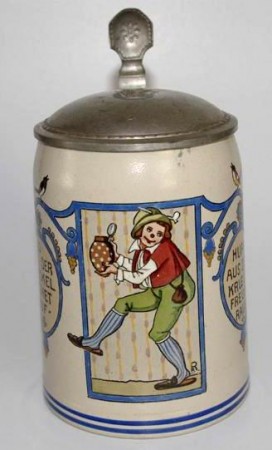 .
. 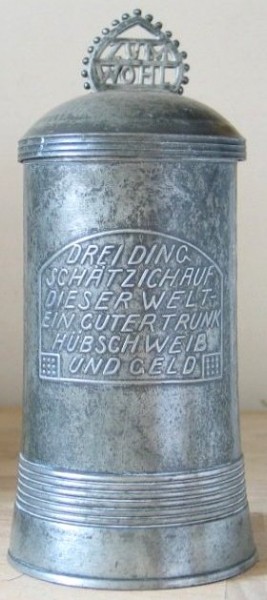
Ringer, Franz – A German artist /graphics designer that designed 100’s of stein decorations which were used by many companies (amongst other works of art.) According to fellow fire-fighter and Californian, SCI MS, Mark Durban; “Many times Ringer designed the whole stein: body shape, pewter and inlay, as well as the body decoration. His stein schemes were not executed just in stoneware, but also in glass and pewter.” Far above = typical Deco design (need new photo ) Just above : .5 liter pewter stein designed by Ringer [Photo comps of SA.] For more on Ringer, please see Mark Durban’s article on Ringer on the SCI web site = http://www.steincollectors.org/ (ADDITIONAL INFO) – Franz Ringer was one of the most popular arts and crafts designers of his time in Munich, designing everything from building facades, interiors of rooms and taverns, furniture, lighting fixtures and much more. He created wooden cutout figures for May poles, sun dials, toys, book illustrations and postcards. And to top it off, he was one of the most prolific designers of beer steins! He did not design just the decoration, but in many cases the whole stein: Body shape, pewter and inlay, as well as the body decoration. His stein schemes were not executed just in stoneware, but also in glass and pewter. The size of these steins range at least from .05 (1/20) liter to 4.1 liters. He was one of very few artists able to cross over the line of patterns and styles of the “historic” and “Jugendstil” periods. Not only did he design in both styles, but he often combined the two. We have seen steins with Jugendstil (art nouveau) body design, but the figures on the stein are dressed in Biedermeier era clothing. Ringer was also one of just a few artists who designed character steins as well as the traditional type. Franz Ringer was born in October of 1865, (Unknown source.)
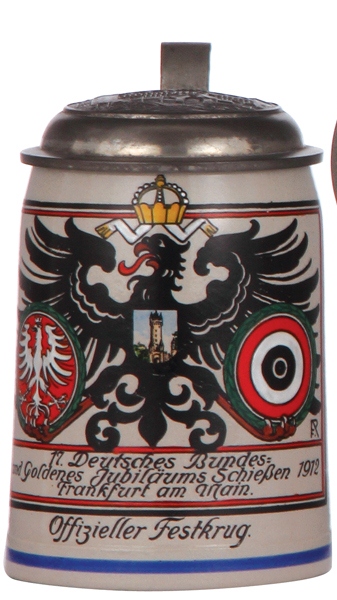
17. Deutsches Bundes und Goldenes Jubiläums Schiessen Frankfurt a. M. 1912,
For more on Ringer on a not too long , but interesting video on “You -Tube” produced by Erste Gruppe (SCI’s Chapter in California) = http://www.youtube.com/watch?v=YWV6nente3U
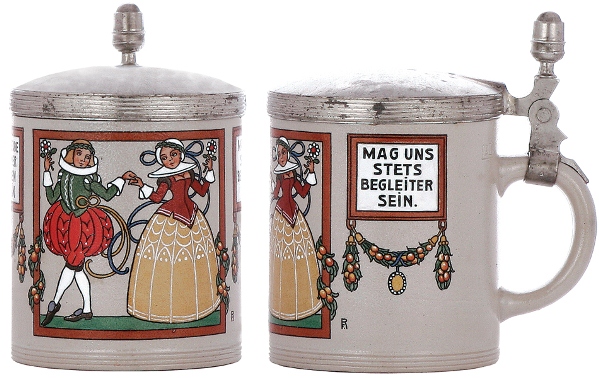 Stoneware stein, showing Ringer’s logo (signature.) [tsaco]
Stoneware stein, showing Ringer’s logo (signature.) [tsaco]
Ringflasche – German for a “Ring Flask,” a smaller version of the Ring Jug seen just below. Most often found e=with rope anchors coming from both sides of the round body. Shown ▼: A Ca. 1890. Westerwald stoneware “Moon Flask” without the ring on the outside being open in the center. St. Hubertus scene. A Ring “Flask” is less than 10 inches tall normally. SEE: 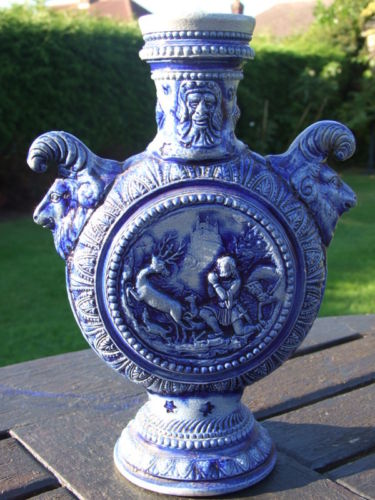
This photo is not a ring flassche It is what we (Dave and I ) are now calling a “Moon Flask” as the center is completely covered.
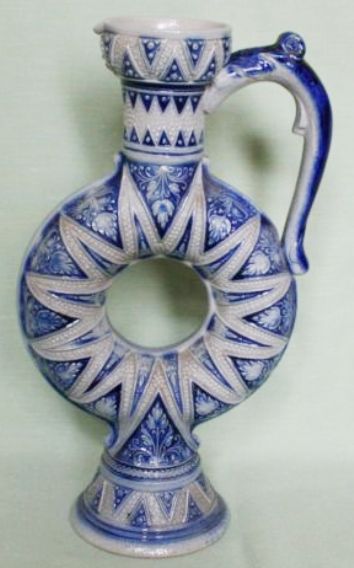
Ring jug – (Self explanatory but different than a jug with a ring!) Note that the small stoneware ring in the grotesque’s (not a bird) mouth is missing, a most common fault. Shown above ▲ : Two styles of “Ring Jugs” from the German Westerwald, both later 1800’s. For more info see: http://www.steveonsteins.com/the-beauty-of-the-historismus-period19th-century-wine-jugs-from-the-westerwald-and-regensberg-including-the-ring-jugs-awpd-12-29-12
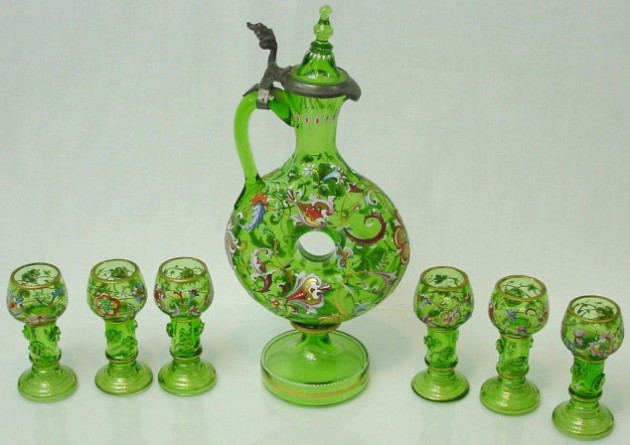
Not to be outdone, this nice looking wine set was made by Eggerman [?] about 1890. The process of making the ring jug was very hard work and not many are found in glass.
**Double ring jug ▼– Comes with two large circular rings making it appear to have 4 sides. Most often found in a large size, these saltglazed stoneware “ring jugs” were both made in the Westerwald and Regensburg city and copy the older 1500 -1600’s versions, many of which were not colored. Also see: “Triple half-a-ring jug” three photos below.
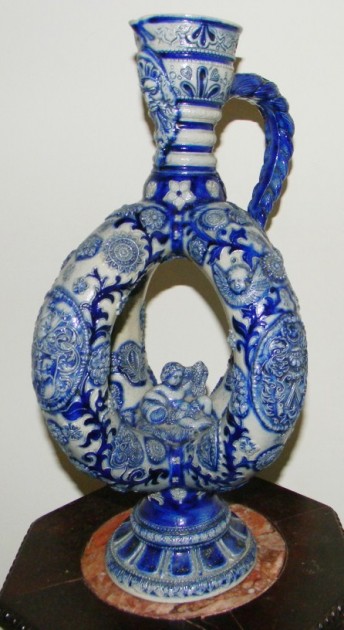
A Regensberg double ring jug with a molded baby Bacchus and a barrel sitting at the junction. [FWTD]
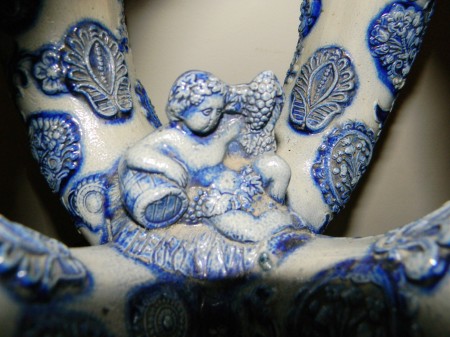
Detail of baby Bacchus, grapes and a keg.
Triple, half-a-ring jug. ▼ 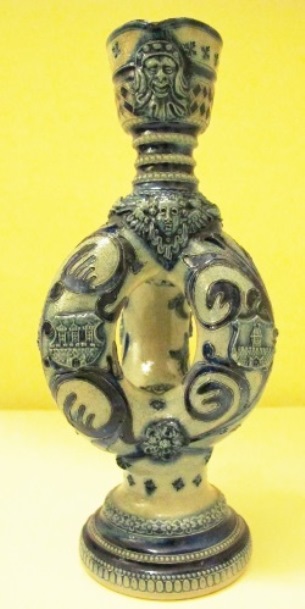
9 in. tall stoneware “triple half-a-ring” jug. Westerwald. Ca. 1890.
Rip van Winkle – (Folk story) –
Ritter – An assumed distributor of steins . See: http://www.steinmarks.co.uk/pages/pv.asp?p=stein744
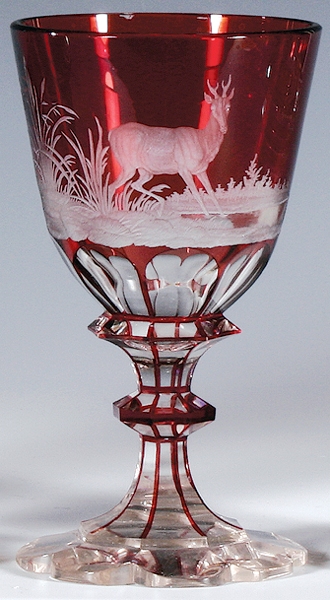
Roebuck – A smaller German Male deer of the Roe family. Shown ▲: Bohemian ruby stained, cut-to-clear pokal; probably sans lid! Circa 1870, with excellent wheel cutting.
Roemer – A wine glass from the Rhine – Mosel river’s area, for drinking white wine. Originally made of dark green “waldglas.” Shown above ▲: German, made of .800 silver, 8 inches tall. Ca. 1890.
![KEGELS - RARE ALL NINE ROEMER TH [Q] 10.5 inches tall](http://www.steveonsteins.com/wp-content/uploads/2013/03/KEGELS-RARE-ALL-NINE-ROEMER-TH-Q-10.5-inches-tall-472x630.jpg)
▲ A glass Roemer obviously for someone who liked German white wine with his Kegels better than beer. For more on this sport See: http://www.steveonsteins.com/kegels-and-pigs-the-predecessors-to-our-10-pins.
For much more about Roemers See: http://www.steveonsteins.com/in-the-near-future-2-1-1
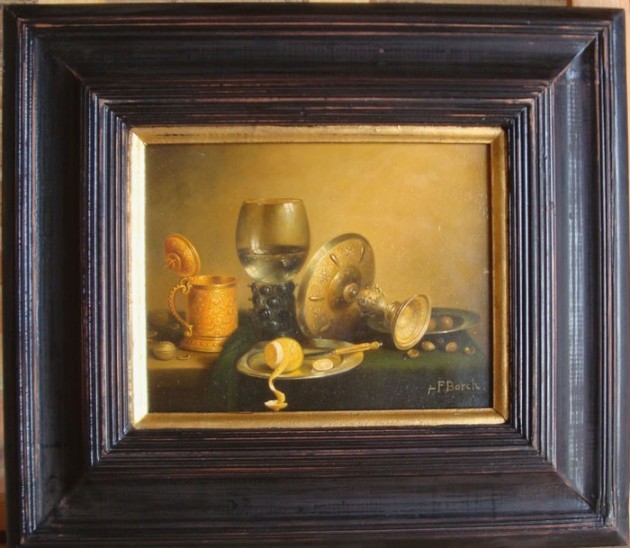
![DOG - RDY Stoneware stein, 1.0L, transfer & enameled, signed A.R., Man with Dachshund, pewter lid, [tsaco]](http://www.steveonsteins.com/wp-content/uploads/2013/06/DOG-RDY-Stoneware-stein-1.0L-transfer-enameled-signed-A.R.-Man-with-Dachshund-pewter-lid-tsaco.jpg) Roessler, A. – Designer for many stein companies around the turn of the 19th to 20th century. Shown above ▲: A1 liter stoneware stein, transfer & enameled, pewter lid for Kgl. Hofbräuhaus München. Man with Dachshund and beer on a sunny day. 1.0L. stoneware stein, transfer & enameled. Signed “A.R.” = A. Roessler. [tsaco]
Roessler, A. – Designer for many stein companies around the turn of the 19th to 20th century. Shown above ▲: A1 liter stoneware stein, transfer & enameled, pewter lid for Kgl. Hofbräuhaus München. Man with Dachshund and beer on a sunny day. 1.0L. stoneware stein, transfer & enameled. Signed “A.R.” = A. Roessler. [tsaco] 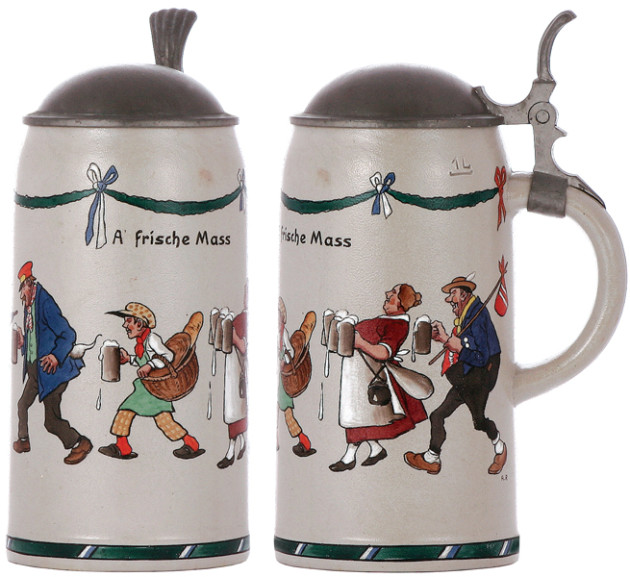
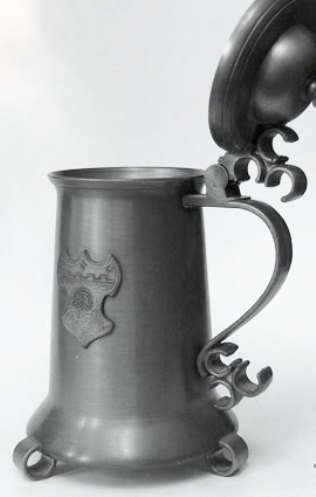
Rolled circular feet – Seldom. if ever seen on older pewter steins. This early stein was made by Otto Vogel and is very new. Rolled Plate (R.P.) — See “Sheffield Plate.”
Romanian drinking vessels – Not many come up on the web or in USA collections, so we’ll have to settle for theses displays, which are probably some of the best examples. 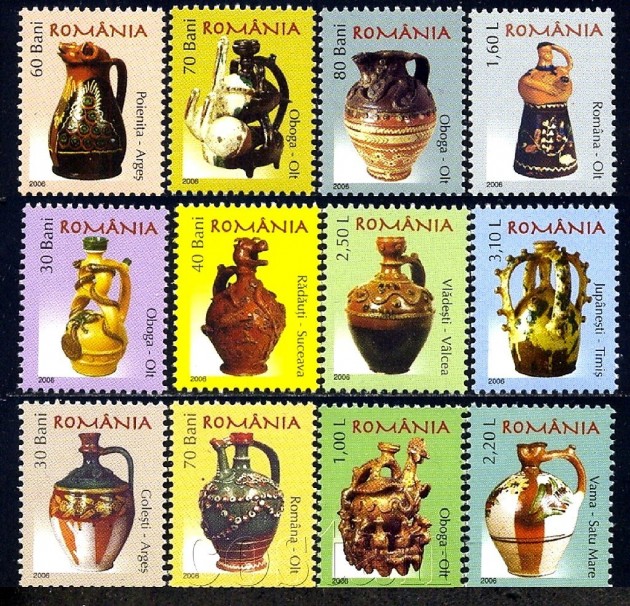
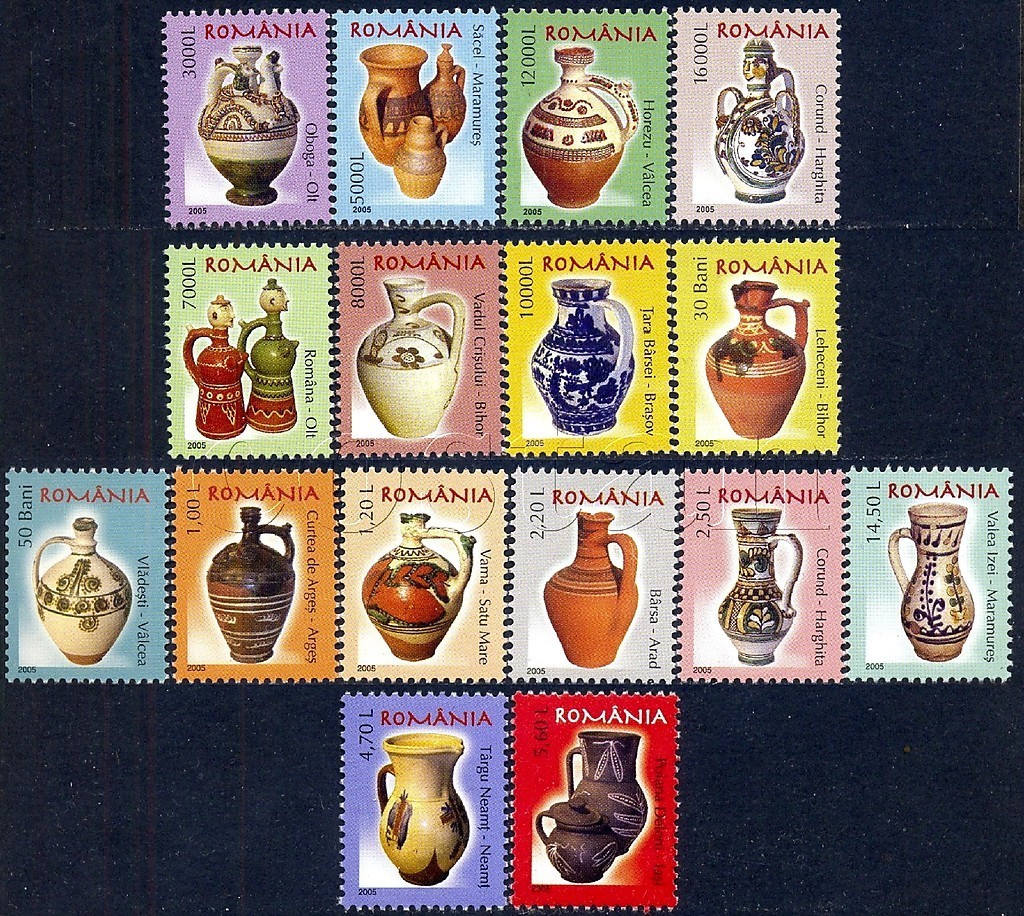 The two to the far right 2md row from bottom [in green and pink surround ] can be easily taken for Hungarian piece, There is not much difference, if any, between the two beer mugs on the far right second level up, and two I believe were made in Hungary. At least I bought them from a Hungarian dealer. See below .▼
The two to the far right 2md row from bottom [in green and pink surround ] can be easily taken for Hungarian piece, There is not much difference, if any, between the two beer mugs on the far right second level up, and two I believe were made in Hungary. At least I bought them from a Hungarian dealer. See below .▼ 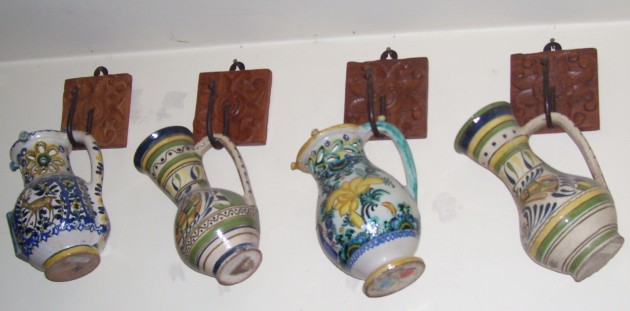 Far left and inside right : These are pottery puzzle mug from Slavokia and the inside left and far right are Hungarian or Romanian. [FWTD] RMG – (maker’s mark) / RM [inside a large G] = Reinhold Merkelbach, Grenshausen. See: http://www.steinmarks.co.uk/pages/pv.asp?p=stein1 Rookwood Pottery, Cincinnati, Ohio –– See article –http://www.beerstein.net/articles/rookwood.htm
Far left and inside right : These are pottery puzzle mug from Slavokia and the inside left and far right are Hungarian or Romanian. [FWTD] RMG – (maker’s mark) / RM [inside a large G] = Reinhold Merkelbach, Grenshausen. See: http://www.steinmarks.co.uk/pages/pv.asp?p=stein1 Rookwood Pottery, Cincinnati, Ohio –– See article –http://www.beerstein.net/articles/rookwood.htm 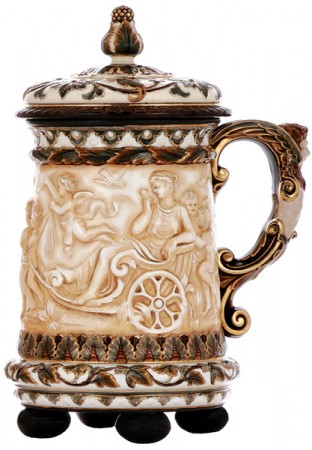 A very large (13 inches tall,) relief porcelain set-on-lid stein – used for display only, as itwould be too heavy with beer in it. [Stephen Smith Collection]
A very large (13 inches tall,) relief porcelain set-on-lid stein – used for display only, as itwould be too heavy with beer in it. [Stephen Smith Collection] 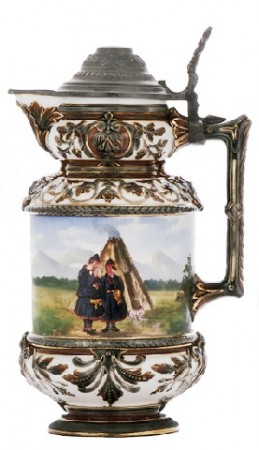 .
. 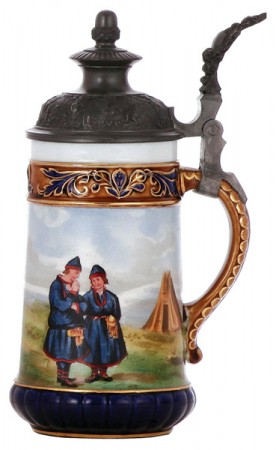 Rorstrand – Swedish porcelain manufacture. I am 100% certain this series came without pewter lids, they were added later. See page this web site: http://www.steveonsteins.com/rorstrand-pottery-beer-steins-servers-beakers-etc-awpd Also See: http://www.steinmarks.co.uk/pages/pv.asp?p=stein1
Rorstrand – Swedish porcelain manufacture. I am 100% certain this series came without pewter lids, they were added later. See page this web site: http://www.steveonsteins.com/rorstrand-pottery-beer-steins-servers-beakers-etc-awpd Also See: http://www.steinmarks.co.uk/pages/pv.asp?p=stein1 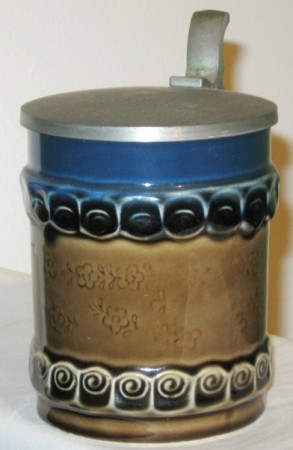
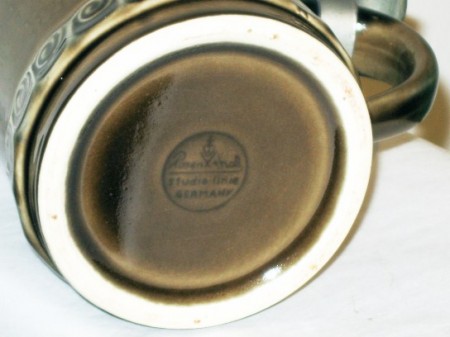 Rosenthal – Bohemian ceramic stein maker. Phillip Rosenthal (1855-1937) began business in 1884 by purchasing white ware from Hutschenreuther and selling designs, handpainted by his wife Maria, door to door. In 1891, he established a factory in Asch, Bohemia and began production of white ware for use in his workshop. From 1897 to 1936, Rosenthal acquired factories in Kronach, Marktredwitz, Selb, Waldenburg, Sophienthal, and Waldershof. The popularity of the Maria White and Moss Rose patterns helped the business grow rapidly. By the time of WWII, Rosenthal operated 10 companies and employed over 5,000 people. When the war ended, Rosenthal’s son, Phillip, returned to Germany where he modernized out of date factories and reestablished lost markets. Phillip quickly rebuilt the business by reaching new markets interested in the modern shapes and artistry of his dinnerware. [Sourse: http://www.chinafinders.com.au/Histories.asp] For more company info see: http://www.steinmarks.co.uk/pages/pv.asp?p=stein1
Rosenthal – Bohemian ceramic stein maker. Phillip Rosenthal (1855-1937) began business in 1884 by purchasing white ware from Hutschenreuther and selling designs, handpainted by his wife Maria, door to door. In 1891, he established a factory in Asch, Bohemia and began production of white ware for use in his workshop. From 1897 to 1936, Rosenthal acquired factories in Kronach, Marktredwitz, Selb, Waldenburg, Sophienthal, and Waldershof. The popularity of the Maria White and Moss Rose patterns helped the business grow rapidly. By the time of WWII, Rosenthal operated 10 companies and employed over 5,000 people. When the war ended, Rosenthal’s son, Phillip, returned to Germany where he modernized out of date factories and reestablished lost markets. Phillip quickly rebuilt the business by reaching new markets interested in the modern shapes and artistry of his dinnerware. [Sourse: http://www.chinafinders.com.au/Histories.asp] For more company info see: http://www.steinmarks.co.uk/pages/pv.asp?p=stein1 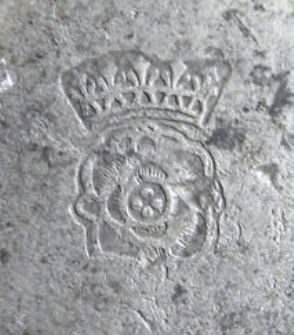 Rose mark – The impressed / stamped mark into the pewter (whatever), showing a large Rose (mostly found with a crown.) This is a quality mark for most of Northern Europe in the olden days. It is still found on reproductions and some newly made pewter steins. &
Rose mark – The impressed / stamped mark into the pewter (whatever), showing a large Rose (mostly found with a crown.) This is a quality mark for most of Northern Europe in the olden days. It is still found on reproductions and some newly made pewter steins. &
gt; 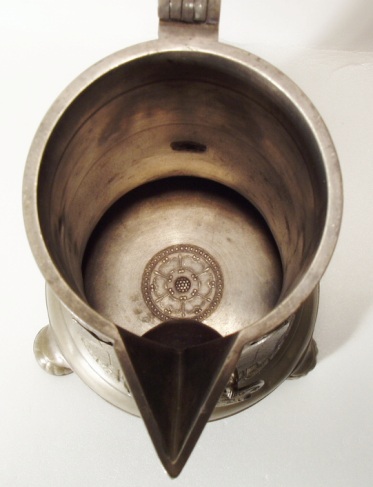 Rosette (and Bodenrosette– [1] A molded relief maker’s mark found on the inside bottom of some pewter steins. mostly South German and Austrian, as above. The official name for this stamp is BODENROSETTE, however being American we have shortened the everyday use of the word to simple Rosette which many times complicates the communication process of talking about pewter steins due to [2] just below ▼. [2] The covering of the pewter hinge on a stein when it is molded with a fancy design, and not just a smooth button. Shown below: A “rosette” covering the hinge on a Theresienthal server.
Rosette (and Bodenrosette– [1] A molded relief maker’s mark found on the inside bottom of some pewter steins. mostly South German and Austrian, as above. The official name for this stamp is BODENROSETTE, however being American we have shortened the everyday use of the word to simple Rosette which many times complicates the communication process of talking about pewter steins due to [2] just below ▼. [2] The covering of the pewter hinge on a stein when it is molded with a fancy design, and not just a smooth button. Shown below: A “rosette” covering the hinge on a Theresienthal server. 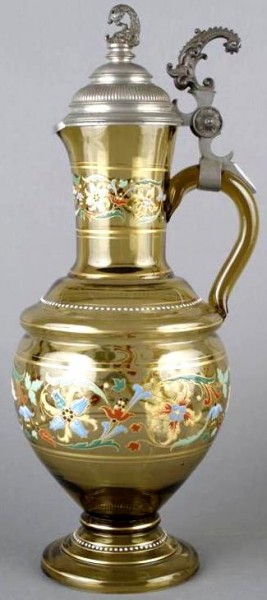
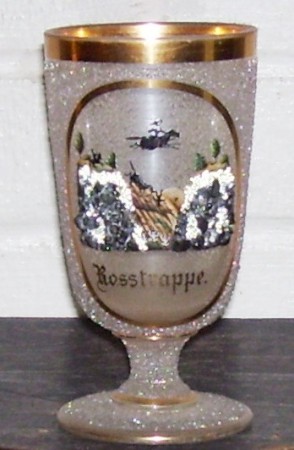 .
. 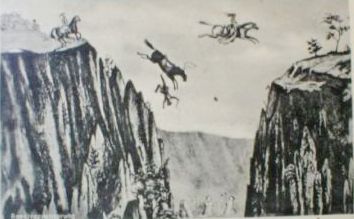 Rosstrappe – A famous mountain location in Germany where a woman on horseback out jumped a stupid male (who was after her body) making it from one side of a cliff to the other, while he did not. Her horse’s shoes hit so hard they have left an imprint into the stone ever since (a natural rock formation – but a great story.) Shown two above: Applied crushed glass on clear glass beaker, about 5 inches, with very heavy enameling showing the woman jumping the gorge. C. 1880. [FWTD] Above: A print showing the pursuit a little better. This beaker is listed on my “For sale” page.
Rosstrappe – A famous mountain location in Germany where a woman on horseback out jumped a stupid male (who was after her body) making it from one side of a cliff to the other, while he did not. Her horse’s shoes hit so hard they have left an imprint into the stone ever since (a natural rock formation – but a great story.) Shown two above: Applied crushed glass on clear glass beaker, about 5 inches, with very heavy enameling showing the woman jumping the gorge. C. 1880. [FWTD] Above: A print showing the pursuit a little better. This beaker is listed on my “For sale” page. 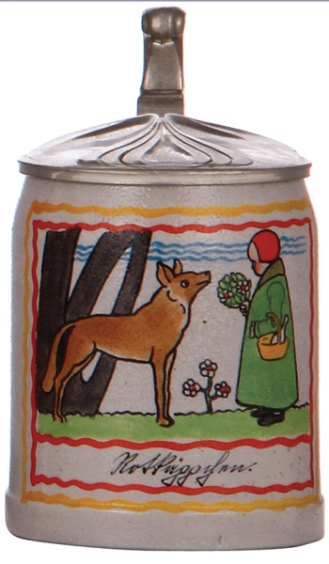 “ROTKÖPPCHEN”, or “LIittle Red Cap” (English: Red Riding Hood) – One of, if not the most famous of all the German Fairy Tales. Many steins are devoted to her. Shown: Stoneware stein, .25L, (5.2″ ht.) transfer & enameled. Designed by F. Ringer. [TSACO] Also see “Some German Fairy Tails”: http://www.steveonsteins.com/some-german-fairy-tales-on-kinders-wrk-draft-stdtd-11-27
“ROTKÖPPCHEN”, or “LIittle Red Cap” (English: Red Riding Hood) – One of, if not the most famous of all the German Fairy Tales. Many steins are devoted to her. Shown: Stoneware stein, .25L, (5.2″ ht.) transfer & enameled. Designed by F. Ringer. [TSACO] Also see “Some German Fairy Tails”: http://www.steveonsteins.com/some-german-fairy-tales-on-kinders-wrk-draft-stdtd-11-27 ![! - J ROUNE [MAKER] ANCIENNE CHOPE A BIÈRE - 1](http://www.steveonsteins.com/wp-content/uploads/2013/03/J-ROUNE-MAKER-ANCIENNE-CHOPE-A-BIÈRE-1.jpg) Roune, J – Small production maker of majolica type steins. French? Ca 1880.Not listed at “Stein Marks” web site. .
Roune, J – Small production maker of majolica type steins. French? Ca 1880.Not listed at “Stein Marks” web site. . ![! - J ROUNE [MAKER]ANCIENNE CHOPE A BIÈRE - 2](http://www.steveonsteins.com/wp-content/uploads/2013/03/J-ROUNE-MAKERANCIENNE-CHOPE-A-BIÈRE-2.jpg) Details of the above stein.
Details of the above stein. 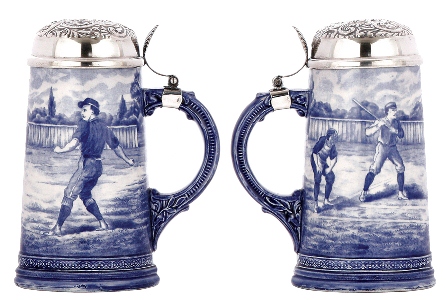 Royal Bonn steins – Shown: .5 liter Baseball scene with silver lid. This series is mistaken for Lenox steins a lot. See: http://www.steinmarks.co.uk/pages/pv.asp?p=stein148
Royal Bonn steins – Shown: .5 liter Baseball scene with silver lid. This series is mistaken for Lenox steins a lot. See: http://www.steinmarks.co.uk/pages/pv.asp?p=stein148 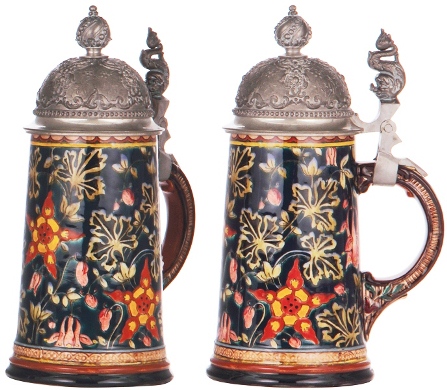 Another version of Royal Bonn steins. PDG = Pretty Damn Gaudy, but check out the Dolphin thumblift.
Another version of Royal Bonn steins. PDG = Pretty Damn Gaudy, but check out the Dolphin thumblift. 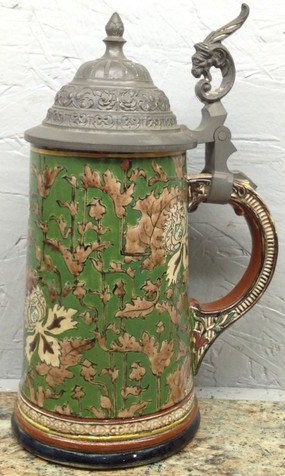 .
. 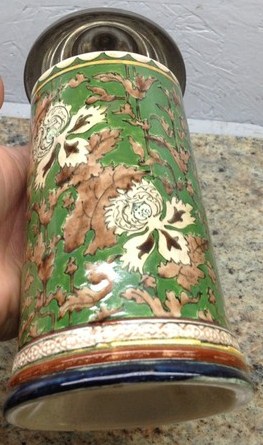 And another off beat, mosaic type of design. Mark below.
And another off beat, mosaic type of design. Mark below. 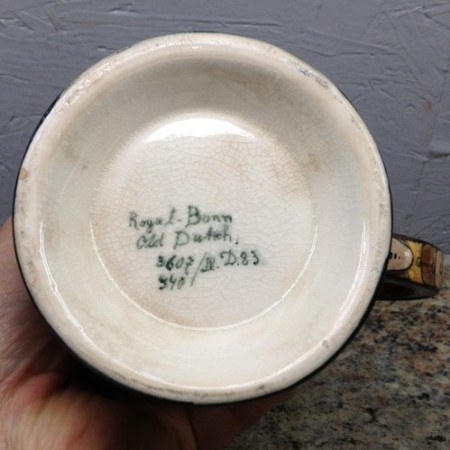
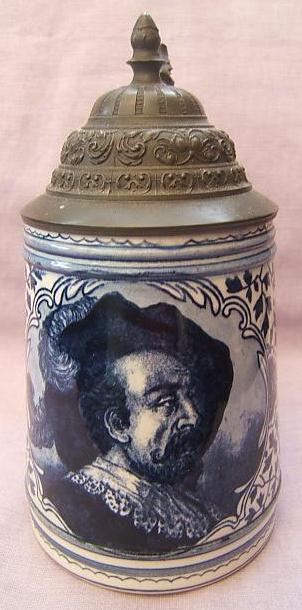
. 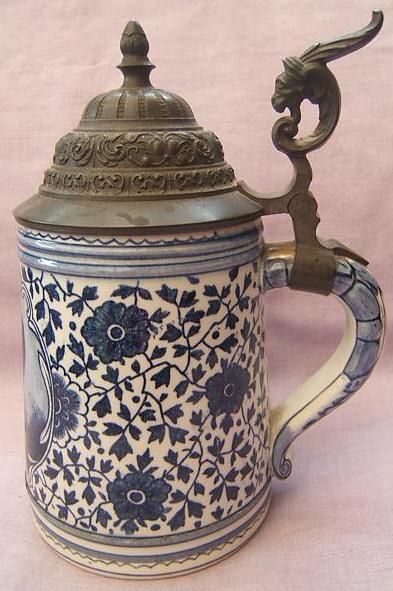 . .
. . 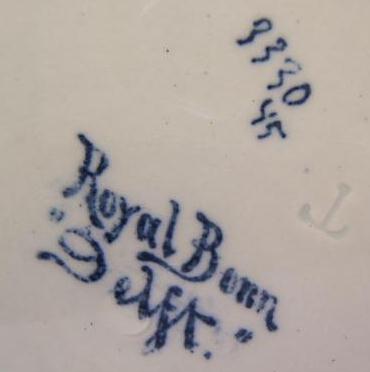 Above three: Another one which is more in line with those the firm is known for. A.5 liter, with its Delft mark. Ca, 1890
Above three: Another one which is more in line with those the firm is known for. A.5 liter, with its Delft mark. Ca, 1890 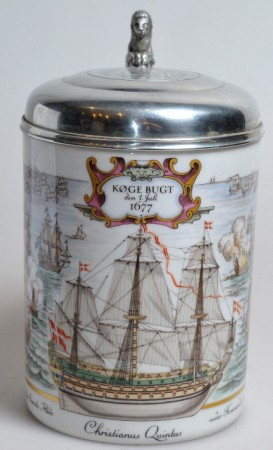 . .
. .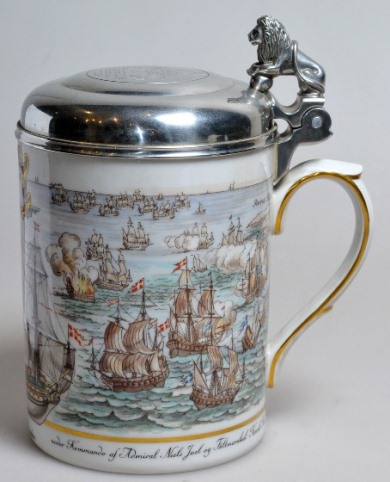
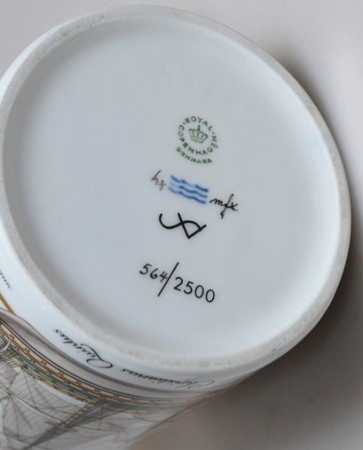 Royal Copenhagen steins – The Royal Danish Porcelain Manufactory, which later became Royal Copenhagen, was founded as the result of experiments carried out by the pharmacist, Frantz Heinrich Müller (1738-1820). For more info see: http://www.steinmarks.co.uk/pages/pv.asp?p=stein1
Royal Copenhagen steins – The Royal Danish Porcelain Manufactory, which later became Royal Copenhagen, was founded as the result of experiments carried out by the pharmacist, Frantz Heinrich Müller (1738-1820). For more info see: http://www.steinmarks.co.uk/pages/pv.asp?p=stein1 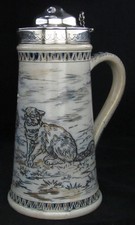 Silver lidded Doulton beer server . with incised cats. 10 inches tall. Royal Doulton – The name of Royal Doulton is today synonymous with the best in English fine bone china tableware alongside their crinolined lady figurines. So it’s difficult to believe that the company’s fortunes were founded upon the making of salt glazed stoneware sewer pipes. It all began shortly after the Battle of Waterloo when in 1815 a young John Doulton set up his own pottery in Fulham at a cost of £100. Henry Doulton, son of the founder, was responsible for the diversification from sanitary and other industrial and chemical products. The situation of the pottery close to the Lambeth School of Art prompted Sir Henry, to employ several lady students and set up an Art Pottery which grew throughout the 1870’s. Since then the company has achieved international fame for its extensive range of wares and products Since then the company has achieved international fame for its extensive range of wares and products. There are no shortage of collectors for virtually anything carrying the Doulton and Royal Doulton trademarks. The Royal Warrant being awarded in 1901 by Edward the Seventh. Possibly the most desirable of all Doulton’s products were made at this period of the firms history – stoneware art pottery. Doulton collectors understand that when it comes to collecting stonewares its usually a question of names and size. Important artists to look out for include the great and celebrated Victorian sculptor, George Tinworth, Mark V Marshall and his grotesque beasts, Frank Butler and his high relief work. The most prominent lady artists were the Barlow sisters of Hannah, Florence and Lucy, Hannah being the more famous of the three. Others are Eliza Simmance, John Broad and the work of decorators and designers such as Francis C Pope, Harry Simeon, Leslie Harradine, Vera Huggins and Agnete Hoy (Comps of AD Antiques Ltd. Gloucestershire
Silver lidded Doulton beer server . with incised cats. 10 inches tall. Royal Doulton – The name of Royal Doulton is today synonymous with the best in English fine bone china tableware alongside their crinolined lady figurines. So it’s difficult to believe that the company’s fortunes were founded upon the making of salt glazed stoneware sewer pipes. It all began shortly after the Battle of Waterloo when in 1815 a young John Doulton set up his own pottery in Fulham at a cost of £100. Henry Doulton, son of the founder, was responsible for the diversification from sanitary and other industrial and chemical products. The situation of the pottery close to the Lambeth School of Art prompted Sir Henry, to employ several lady students and set up an Art Pottery which grew throughout the 1870’s. Since then the company has achieved international fame for its extensive range of wares and products Since then the company has achieved international fame for its extensive range of wares and products. There are no shortage of collectors for virtually anything carrying the Doulton and Royal Doulton trademarks. The Royal Warrant being awarded in 1901 by Edward the Seventh. Possibly the most desirable of all Doulton’s products were made at this period of the firms history – stoneware art pottery. Doulton collectors understand that when it comes to collecting stonewares its usually a question of names and size. Important artists to look out for include the great and celebrated Victorian sculptor, George Tinworth, Mark V Marshall and his grotesque beasts, Frank Butler and his high relief work. The most prominent lady artists were the Barlow sisters of Hannah, Florence and Lucy, Hannah being the more famous of the three. Others are Eliza Simmance, John Broad and the work of decorators and designers such as Francis C Pope, Harry Simeon, Leslie Harradine, Vera Huggins and Agnete Hoy (Comps of AD Antiques Ltd. Gloucestershire 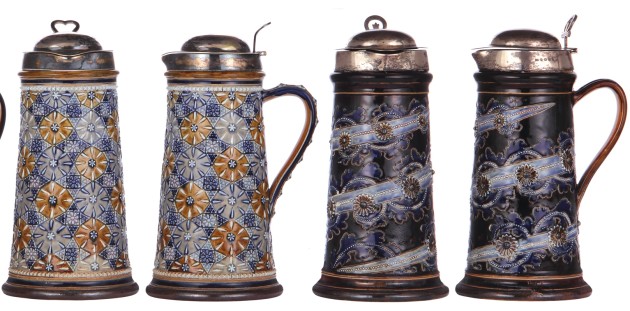 The vast majority of this company’s so called tankards are really only mugs. Lots of English silver smiths have added nice lids to some of these piece and then they do for the most part, look nice and collectable. BUT NOT THE ONE BELOW!!! it makes me sick !!
The vast majority of this company’s so called tankards are really only mugs. Lots of English silver smiths have added nice lids to some of these piece and then they do for the most part, look nice and collectable. BUT NOT THE ONE BELOW!!! it makes me sick !! 
ROYAL GOEDEWAAGEN [Q] PEWTER COVERED MUGS & PITCHER
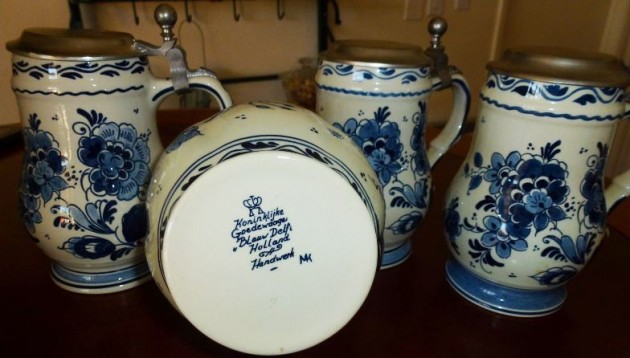
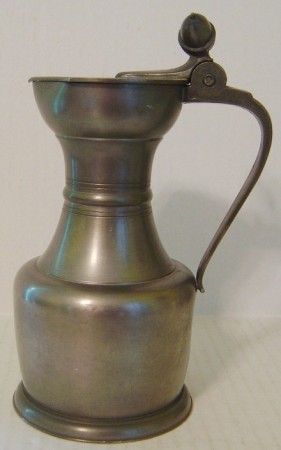 Royal Holland – Maker of pretty cheap pewter wares in the late 20th century. Shown: Their “Daalderop series” flagon. .
Royal Holland – Maker of pretty cheap pewter wares in the late 20th century. Shown: Their “Daalderop series” flagon. . 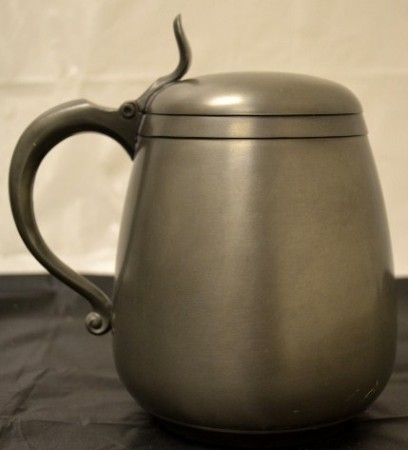 Also “Daalderop” – 36 FL. OZ., 6 inches tall.
Also “Daalderop” – 36 FL. OZ., 6 inches tall. 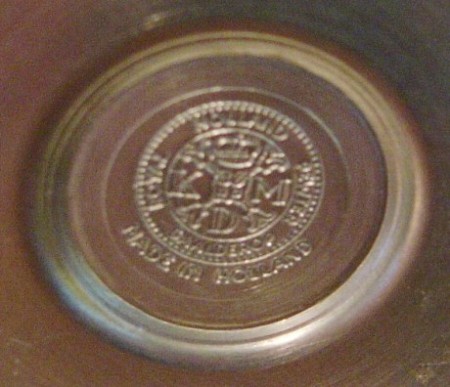 Royal Holland mark.
Royal Holland mark.
Royal Tettau Beer Stein NEW PORCELAIN. A NICE LADY’S STEIN
Royal Tuttau steins – A newer porcelain stein making firm located in Bavaria.
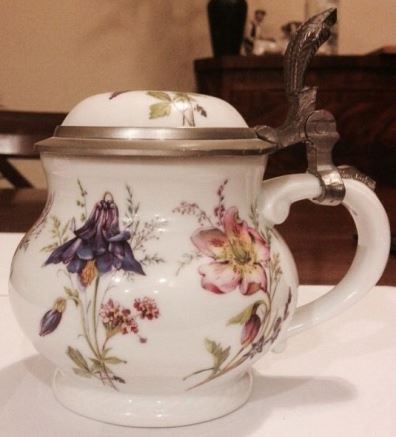
▼ A .5 liter “Irish Onion Pattern” stein (a take off on the “French Onion” only in green!
![Royal Tettau, Bavaria Germany call it IRISH ONION PATTERN [Q],](http://www.steveonsteins.com/wp-content/uploads/2010/10/Royal-Tettau-Bavaria-Germany-call-it-IRISH-ONION-PATTERN-Q-418x450.jpg) Royal Tuttau steins – A newer porcelain stein making firm located in Bavaria. Shown: A .5 liter “Irish Onion Pattern” stein (a take off on the “French Onion” only in green!
Royal Tuttau steins – A newer porcelain stein making firm located in Bavaria. Shown: A .5 liter “Irish Onion Pattern” stein (a take off on the “French Onion” only in green!
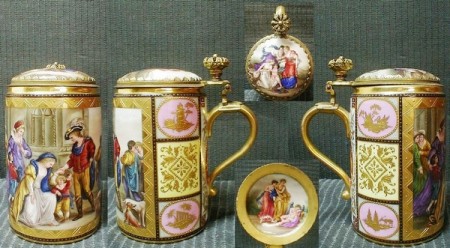 Royal Vienna steins (TYPE) – Excellent quality porcelain steins, hand painted in Vienna. Mostly of mythological scenes, half liter size, and with gold plated brass mounts. Most are seen with a blue “Bee hive” mark, another beer stein misnomer which in reality is representative of the Austrian Coat of Arms turned up side down! (A new page on these beauties should be in development late , 2013? Coming from another Guest Writer )
Royal Vienna steins (TYPE) – Excellent quality porcelain steins, hand painted in Vienna. Mostly of mythological scenes, half liter size, and with gold plated brass mounts. Most are seen with a blue “Bee hive” mark, another beer stein misnomer which in reality is representative of the Austrian Coat of Arms turned up side down! (A new page on these beauties should be in development late , 2013? Coming from another Guest Writer ) 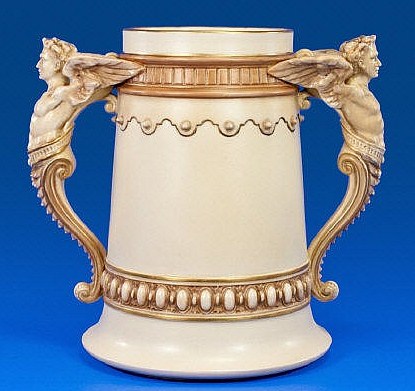 Royal Worcester – Royal Worcester is a British brand known for its history, provenance and classically English collections of porcelain. Now part of the Portmeirion Group, Royal Worcester remains in the luxury tableware and giftware market. After a 1976 merger with Spode,and due to heavy competition from overseas, 100 staff were made redundant in 2003 and another 100 went in 2005. Fifteen porcelain painters left the Severn Street factory on Friday 29 September 2006, together with 100 other workers.The last trading date for Royal Worcester was June 14, 2009. Shown above ▲: A Royal Worcester Pass Cup.” Two figural handles, “Blush Ivory” color. 9 in. . Shown ▼
Royal Worcester – Royal Worcester is a British brand known for its history, provenance and classically English collections of porcelain. Now part of the Portmeirion Group, Royal Worcester remains in the luxury tableware and giftware market. After a 1976 merger with Spode,and due to heavy competition from overseas, 100 staff were made redundant in 2003 and another 100 went in 2005. Fifteen porcelain painters left the Severn Street factory on Friday 29 September 2006, together with 100 other workers.The last trading date for Royal Worcester was June 14, 2009. Shown above ▲: A Royal Worcester Pass Cup.” Two figural handles, “Blush Ivory” color. 9 in. . Shown ▼ 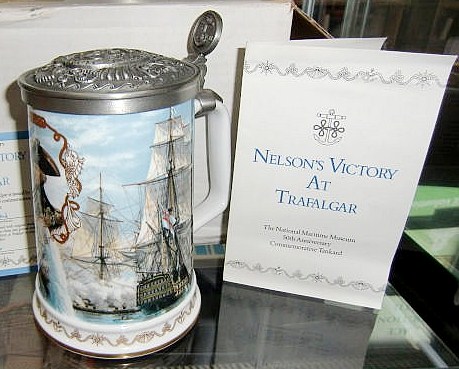 Shown above: A Royal Worcester / National Maritime Museum (England) 50th anniversary commemorative tankard of Nelson’s Victory at Trafalgar, in porcelain and with molded petwer lid. pewter. This stein is very much like the Sea Ship series produced by Havialand and sold through Franklin Mint.
Shown above: A Royal Worcester / National Maritime Museum (England) 50th anniversary commemorative tankard of Nelson’s Victory at Trafalgar, in porcelain and with molded petwer lid. pewter. This stein is very much like the Sea Ship series produced by Havialand and sold through Franklin Mint. 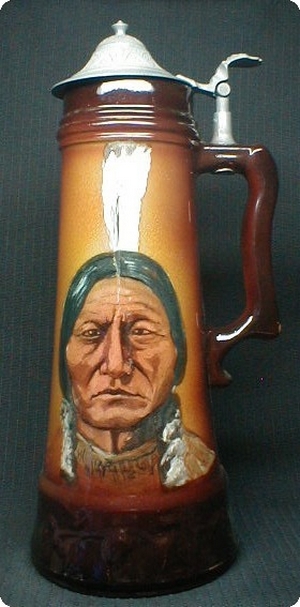
Rozart – An American firm that produced hand painted / PUG [?] pottery steins, sometime around the 1960-70’s. I have no other info at present. Both about 1.5 liters. Lid / thumblift attachment is a bolt through the handle. [SC]
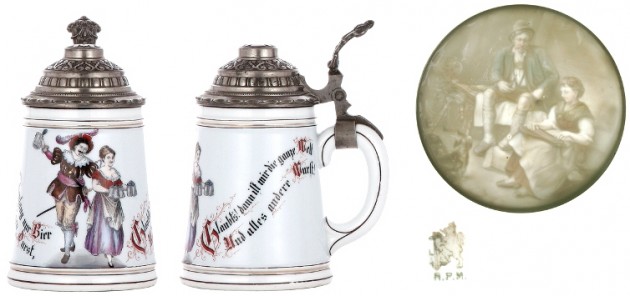 R.P.M., Rheinische Porzellan-Manufaktur (Oscar Erck) 1861 – 1910. – Known in the stein world for their production of porcelain steins many with colored lithophanes.
R.P.M., Rheinische Porzellan-Manufaktur (Oscar Erck) 1861 – 1910. – Known in the stein world for their production of porcelain steins many with colored lithophanes. 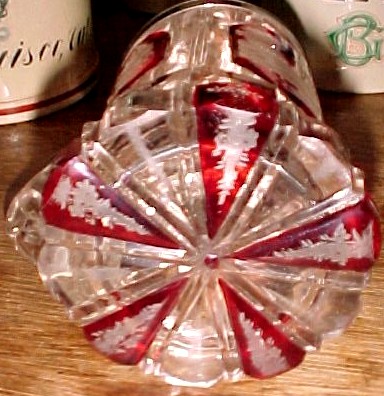 Ruby stained base – Shown ▲ : Heavy cut star pattern, stained and then and engraved. Ruby stained steins – Shown below ▼ ▼ Several nice examples, so new collectors get some idea what’s “out there.” These type steins were VERY popular in the time period of 1840 – 1865.
Ruby stained base – Shown ▲ : Heavy cut star pattern, stained and then and engraved. Ruby stained steins – Shown below ▼ ▼ Several nice examples, so new collectors get some idea what’s “out there.” These type steins were VERY popular in the time period of 1840 – 1865. 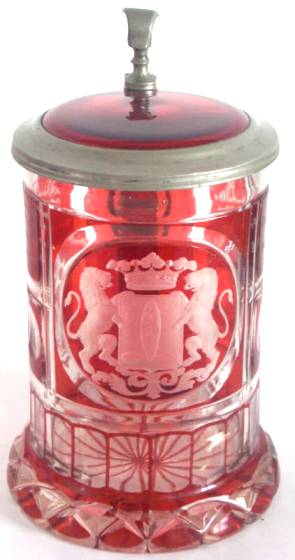 .
. 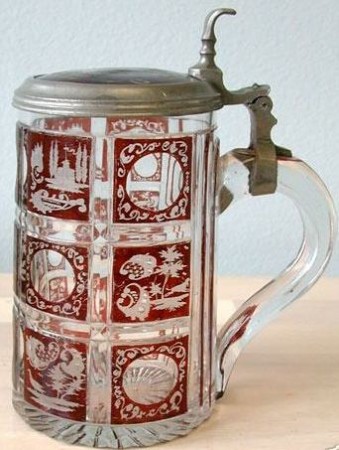
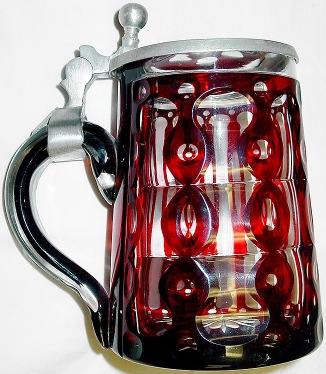
![RSOS - RUBY STAINED - STEINfavorites [13] stand in for cut ruby piano player EXPLAIN TOUCH UP OR NOT TO](http://www.steveonsteins.com/wp-
content/uploads/2014/04/RSOS-RUBY-STAINED-STEINfavorites-13-stand-in-for-cut-ruby-piano-player-EXPLAIN-TOUCH-UP-OR-NOT-TO.jpg) Ruby stained beer steins such as this one ▲ ▲ were expensive as gift and are not found too often It would be rated a 5 on the Smith-Parator Rating scale. See: http://www.steveonsteins.com/rarity-scale-for-all-beer-steins-from-target-practice-to-yard-sale-to-european-museum-quality Rudolstadt 1720-1809 – City or town of major fayence stein production. For more info, see: http://www.thepatriotexchange.com/pss/hisfai.htm Rugby steins – Pretty self explanatory.
Ruby stained beer steins such as this one ▲ ▲ were expensive as gift and are not found too often It would be rated a 5 on the Smith-Parator Rating scale. See: http://www.steveonsteins.com/rarity-scale-for-all-beer-steins-from-target-practice-to-yard-sale-to-european-museum-quality Rudolstadt 1720-1809 – City or town of major fayence stein production. For more info, see: http://www.thepatriotexchange.com/pss/hisfai.htm Rugby steins – Pretty self explanatory. 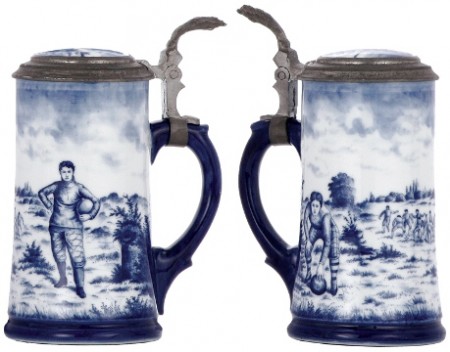 Shown: Porcelain stein, .5L, marked Delft, by Swaine, a rugby game, inlaid lid, lithophane. See: http://www.steinmarks.co.uk/pages/pv.asp?p=stein1
Shown: Porcelain stein, .5L, marked Delft, by Swaine, a rugby game, inlaid lid, lithophane. See: http://www.steinmarks.co.uk/pages/pv.asp?p=stein1 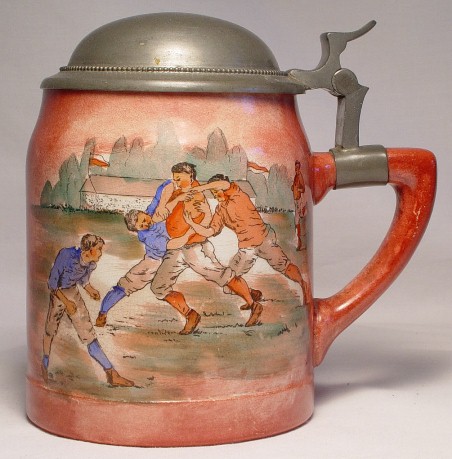 American Rugby stein, made by Manning Bowman. Ca. 1910-30. For company info see: http://www.steinmarks.co.uk/pages/pv.asp?p=stein1 Rule No. 1 of beer stein collecting – Only believe 50% of what you read, and nothing of what you hear! (Except this web site of course!!) Rule No. 2 of beer stein collecting – If the deal seems to be too good to be true, than it probably is not, e.g , it’s a fake, or broken and not called, or the description is wrong, or ___________[you may fill in the blank!} Rule No.3 of beer stein collecting – If you can afford it, buy it when you see it! While it is true of most all manufactured pieces: “If they made one then they made two”, sometimes you may have to wait a long, long time until you see that special piece again. Sometimes never. I could spend hours giving lectures on the stuff I didn’t buy, that later I could have kicked myself about. Rummer – An English deviation of the German word Roemer. “Rummers” were similar shaped vessels, however larger and many times communal. Below: An eighteenth century glass Rummer used for the gentlemen of the choir or the Vicars Choral, now preserved at the Lichfield Cathedral, England. [Below]
American Rugby stein, made by Manning Bowman. Ca. 1910-30. For company info see: http://www.steinmarks.co.uk/pages/pv.asp?p=stein1 Rule No. 1 of beer stein collecting – Only believe 50% of what you read, and nothing of what you hear! (Except this web site of course!!) Rule No. 2 of beer stein collecting – If the deal seems to be too good to be true, than it probably is not, e.g , it’s a fake, or broken and not called, or the description is wrong, or ___________[you may fill in the blank!} Rule No.3 of beer stein collecting – If you can afford it, buy it when you see it! While it is true of most all manufactured pieces: “If they made one then they made two”, sometimes you may have to wait a long, long time until you see that special piece again. Sometimes never. I could spend hours giving lectures on the stuff I didn’t buy, that later I could have kicked myself about. Rummer – An English deviation of the German word Roemer. “Rummers” were similar shaped vessels, however larger and many times communal. Below: An eighteenth century glass Rummer used for the gentlemen of the choir or the Vicars Choral, now preserved at the Lichfield Cathedral, England. [Below] ![RUMMER FOR BEER IN THE LICHFIELD CATHEDRAL, ENGLAND [1]](http://www.steveonsteins.com/wp-content/uploads/2010/10/RUMMER-FOR-BEER-IN-THE-LICHFIELD-CATHEDRAL-ENGLAND-1.jpg) .
. 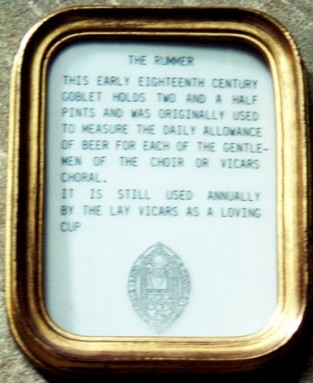 This English drinking glass supposedly gets its name from the German ‘Roemer’ but whoever said one couldn’t be communal with some of the large roemers that are available in Germany? Shown: The most famous Rummer in England, and its posted description, from the Lichfield Cathedral. See: http://www.steveonsteins.com/in-the-near-future-2-1-1-2
This English drinking glass supposedly gets its name from the German ‘Roemer’ but whoever said one couldn’t be communal with some of the large roemers that are available in Germany? Shown: The most famous Rummer in England, and its posted description, from the Lichfield Cathedral. See: http://www.steveonsteins.com/in-the-near-future-2-1-1-2 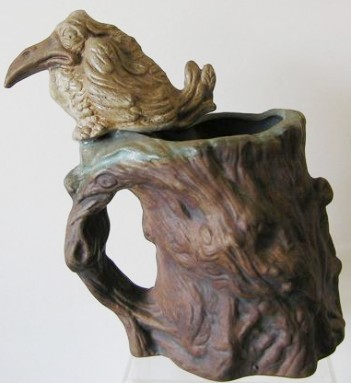 Rumph – A series of fanciful /weird hard pottery / stoneware [I believe] beer mugs produced by Jim Rumph in the USA in the 1970’s. Shown: A 1973 original Jim Rumph “Splatter Bird.” It has bird poop on the mug’s bottom. All very humorous [?] but not too functional.
Rumph – A series of fanciful /weird hard pottery / stoneware [I believe] beer mugs produced by Jim Rumph in the USA in the 1970’s. Shown: A 1973 original Jim Rumph “Splatter Bird.” It has bird poop on the mug’s bottom. All very humorous [?] but not too functional. 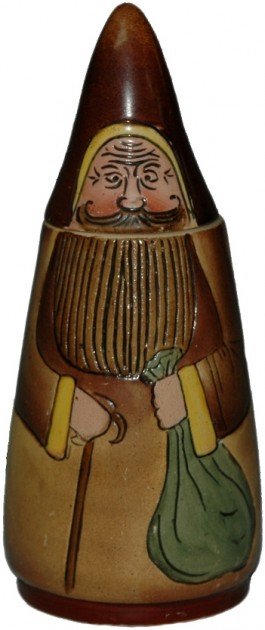 Ruprecht, Knecht – A highly sought after, very little character stein of the individual that goes with St. Nicholas, and give present to the bad kids. [DH]
Ruprecht, Knecht – A highly sought after, very little character stein of the individual that goes with St. Nicholas, and give present to the bad kids. [DH] 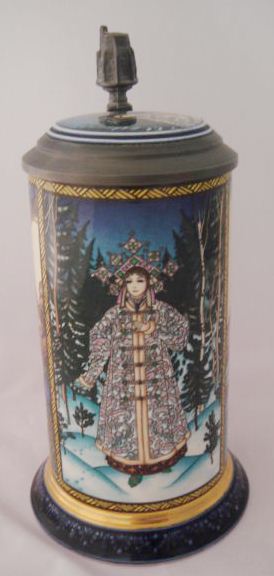 Russian Fairy Tales series. – A new but well done series produced by V & B Mettlach in the 1980’s. There are a total of four steins with three scenes from different stories on each. One of the nicest “New” seri
Russian Fairy Tales series. – A new but well done series produced by V & B Mettlach in the 1980’s. There are a total of four steins with three scenes from different stories on each. One of the nicest “New” seri
es to be made. The Mettlach Chapel (called “Castle” is the thumblift. 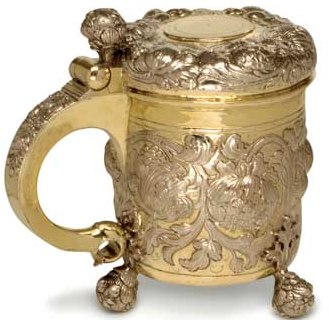 Russian silver steins – This country’s (and the Baltic States under it’s control) silver has seen a monstrous climb upward in prices paid in the last decade. Many new collectors are unaware of the requirement that all major assembled parts of Russian silver pieces had to be marked with the silver’s quality mark (usually 84) therefore one should look for marks on the body, lid and handle at a minimum. If not there, it is a 95% chance it is a fake or modern reproduction. Shown: A Russian silver tankard with a $42,00 asking price in NYC about 2006. For a couple of other nice Russian Silver steins, see: http://www.steveonsteins.com/wp-admin/post.php?post=52&action=edit&message=1 [END – SOK – 82 – R5] WISH TO CONTACT ME ? =
Russian silver steins – This country’s (and the Baltic States under it’s control) silver has seen a monstrous climb upward in prices paid in the last decade. Many new collectors are unaware of the requirement that all major assembled parts of Russian silver pieces had to be marked with the silver’s quality mark (usually 84) therefore one should look for marks on the body, lid and handle at a minimum. If not there, it is a 95% chance it is a fake or modern reproduction. Shown: A Russian silver tankard with a $42,00 asking price in NYC about 2006. For a couple of other nice Russian Silver steins, see: http://www.steveonsteins.com/wp-admin/post.php?post=52&action=edit&message=1 [END – SOK – 82 – R5] WISH TO CONTACT ME ? =  “I have the right to remain silent, but I don’t have the ability.”
“I have the right to remain silent, but I don’t have the ability.”

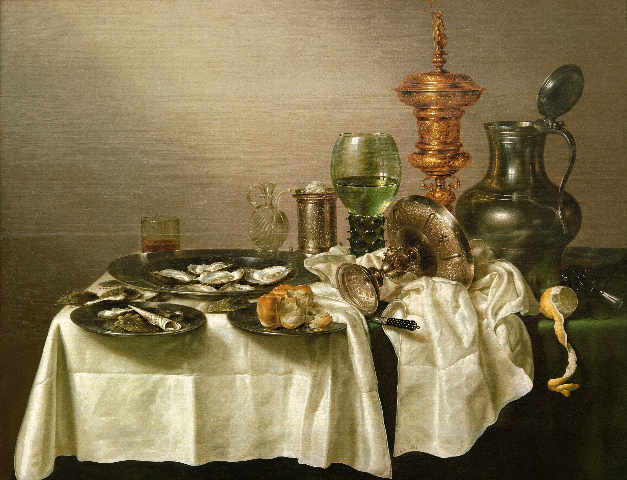
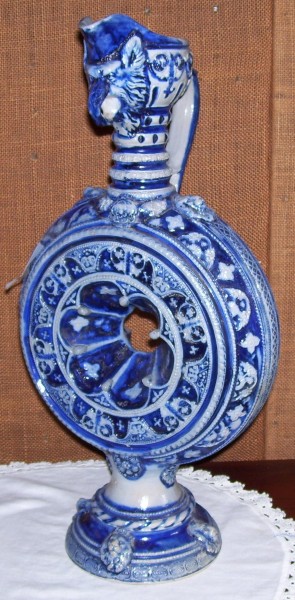
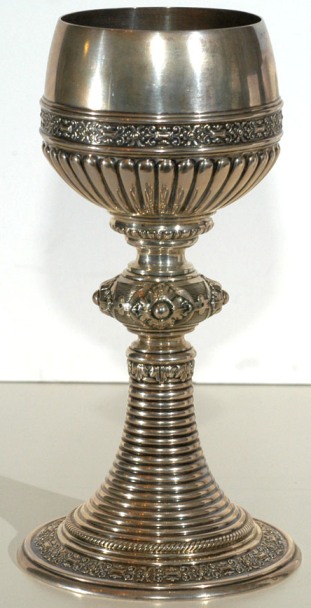
Leave a Reply